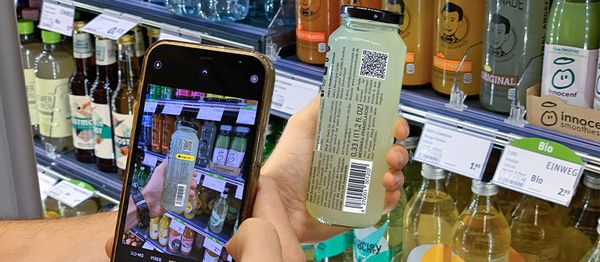One Code for all - Why the future belongs to the 2D Code
In the mid-term, the new 2D code will replace the 1D EAN code worldwide. This is the plan of industry organization GS1. There are the GS1 Digital Link and GS1 Data Matrix variants to choose from. The pixel square can gather all previous data into one code symbol and helps manufacturers make their products more digital and transparent and provide targeted information to different groups. The goal is for the EAN barcode to disappear completely over time.
The design of some packages is barely visible due to the sheer number of labels: The nutritional table, EAN code, best before date and batch number are all crowded together, often accompanied by a QR code for an application video or raffle, and a booklet with recipe suggestions. The new 2D code, for instance as a digital link version, should put an end to this and provide all the information on its own – and much more. The square, consisting of pixel dots, can serve all target groups according to their specific needs: from logistics to wholesale and retail to the end consumer.
The barcodes currently used for product marking are one-dimensional. With parallel bars with various thicknesses and distances, they encode only the fixed article number (GTIN) on the respective product package. This is why they are referred to as “static”.
The visual appearance of the code alone, consisting of a pixelated square, shows that the times are changing. And even the column of numbers from which the new 2D code is developed reveals more than just the article number, namely variable data, which makes it a dynamic code. In the food industry, it also contains the batch number and best before date of the respective product. This offers many advantages for retailers:
- The unique identification of goods allows for traceability, and means that wholesalers or retailers can selectively sort out products instead of destroying entire deliveries.
- Recalls can be done more effectively.
- Products are easier to identify as safe originals.
- Automatic price discounts based on the shelf life are possible if retailers pre-set a period before expiration when the cash register should reduce the price. This can improve food waste management and help reduce food waste.
Gateway to a universe with many different worlds of information
The new code looks like a two-dimensional pixel square. It can be a QR code or a Data Matrix code. Both allow for error detection as well as correction, making them clearly legible even if they are up to 30 percent damaged. But while a QR code usually only leads to a static website, this new code can do much more.
The highlight is: The underlying column of numbers is a URL that leads to a website. The information and content stored there can be changed, updated, or even completely replaced at any time – without having to exchange the 2D code and reprint labels or packaging. The data source can use the coded batch, best before date, or even a serial number to get the user the exact information for a specific product among thousands. With GS1 Digital Link, the destination of the code can be a web portal with a built-in switch, called a “resolver”. If you scan the square with an Internet-enabled device, you are automatically taken to the correct data source by intelligent redirection. This is because the resolver recognizes who has scanned the code and directs users to the environment developed for their target group.
The 2D code is the gateway to a universe of information that opens the window to the world designed for each visitor. For instance, logistics companies can see the target market of the article, retailers can get an overview of stock levels for a particular batch, and retailers can get inspiration for product presentations.
Product becomes touch point for customer loyalty, communication and marketing
The 2D code also has the potential to improve communication with the customer. Stored ingredient lists, proof of origin and nutritional values increase transparency and trust in the product and manufacturer. Sweepstakes, discounts, or seasonal recipes can strengthen brand loyalty. Manufacturers can join their customers on their journey by providing information with the code that is interesting before purchase and also valuable afterwards. And all of this in the respective language of the user. Manufacturers can use the information of how often the digital code was scanned and by whom to draw conclusions for product development.
This turns every single product into a touch point for customer loyalty, communication, and marketing, and also offers opportunities in stationary retail that have so far been the competitive advantage of e-commerce. And it does this with a single code that takes up much less space than the current plethora of labels and makes all others dispensable. On packaging, its attractive design once again takes center stage.
But what do manufacturers and retailers need to take advantage of the new code? And: What do we do if it doesn’t catch on? In many places, the static EAN code is still applied using offset printing or gravure printing, which is not suitable for applying dynamic codes. In many areas, continuous inkjet (CIJ) technology has been used up to now. However, with its low print resolution, the font quality is only suitable to a limited extent for printing 2D checkout codes in good quality at high speeds for high first-pass reading rates at the point of sale. Anyone who doesn’t want to miss out on this development should switch to modern, high-resolution and maintenance-free printing systems now. These systems should integrate quickly and easily into the control unit of production machines and obtain the content for printing 2D codes with variable data via interfaces. They should also still be able to print the old codes for the transition period or for market participants who decide against the 2D code or need more time to change over.
However, the question is not only which systems are suitable for reliable marking, but also what means are suitable for ensuring code quality for high first-pass reading rates. When a code is used throughout the entire process chain, monitoring the print quality becomes more important in addition to how it is applied. Manufacturers are therefore advised to verify the code quality immediately after application and before shipping the goods – either inline or at least on a random basis.
Anyone looking to improve customer relationships, optimize processes and free product designs from unnecessary labeling now have a chance to take on the substitution of old printing systems with high-resolution thermal inkjet (TIJ) technology, laser or coding and labeling systems with REA Elektronik. REA Elektronik has an extensive product range for all these requirements with its REA JET, REA LABEL and REA VERIFIER product lines for industrial marking, labeling and code verification. The company is a GS1 solution provider and, with its experts in the national 2D expert group of GS1, will accompany the global migration to the 2D Data Matrix code and help develop its specifications.
The REA JET HR product family, cartridge-based TIJ printing systems, applies marking directly to the product or packaging at high speed and with high quality. With the right inks, direct printing on paper, plastic, foils, or metal is possible, also in the REA wet-on-wet printing process. REA JET piezo printing systems, such as the new REA JET UP, are recommended for marking secondary packaging. They provide reliable, high-contrast marking even on smooth substrates, such as paint or varnish. The laser marking systems from REA JET make permanent marks directly on paper, plastic, ceramics, or metallic surfaces with bundled light and without consumables. And if direct marking with inkjet printers or lasers is not an option, REA LABEL labeling solutions are there – from simple desktop label printers to complex labeling machines. The REA VERIFIER systems for verification use inline or random tests to ensure that codes have been printed without errors and with high quality, in accordance with the international standard specifications and with high first-pass reading rates at checkout. Finally, REA Card checkout systems can already read and process the new 2D code.
And if, despite its many advantages, the 2D digital code does not take off after all, manufacturers will have taken an important step towards modernizing their marking processes and reducing costs by switching to flexible and high-performance printing systems.
Visit REA Elektronik at the Interpack 2023 from May 4 to 10, 2023 in Dusseldorf, Germany: Hall 8B, Booth C17. www.rea.de
Author: Wilfried Weigelt, Head of Department REA VERIFIER at REA Elektronik




